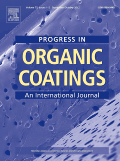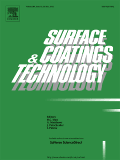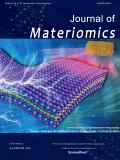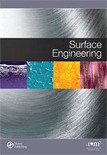
PROGRESS IN ORGANIC COATINGS
Scope & Guideline
Leading the Charge in Coatings Innovation and Application
Introduction
Aims and Scopes
- Anti-corrosion Coatings:
Research on coatings designed to protect metals and other substrates from corrosion, utilizing various materials such as epoxy, polyurethane, and graphene oxide to enhance durability and resistance. - Self-healing Coatings:
Development of coatings that can autonomously repair damage, often through the incorporation of microcapsules or other systems that release healing agents upon damage. - Functional Coatings:
Coatings that provide additional functions such as antimicrobial properties, superhydrophobicity, or flame retardancy, enhancing the performance of materials in specific applications. - Biobased and Eco-friendly Coatings:
Focus on sustainable materials derived from natural resources, aiming to reduce environmental impact while maintaining high performance in coatings. - Nanocomposite Coatings:
Investigation into coatings that incorporate nanoparticles or nanostructured materials to improve mechanical, thermal, and barrier properties. - Smart Coatings:
Research on coatings that respond dynamically to environmental stimuli, such as pH or temperature changes, for applications in various fields including healthcare and electronics. - Waterborne Coatings:
Emphasis on the development of environmentally friendly coatings that use water as a solvent, reducing volatile organic compound (VOC) emissions. - Coating Performance Assessment:
Studies focusing on the evaluation of the performance of coatings under various conditions, including mechanical stress, chemical exposure, and environmental factors.
Trending and Emerging
- Sustainable and Biobased Materials:
There is a growing emphasis on the use of sustainable materials and biobased polymers in coatings, reflecting a shift towards environmentally friendly practices. - Nanotechnology in Coatings:
The integration of nanotechnology into coatings to enhance properties such as strength, durability, and functionality is increasingly prevalent, showcasing the potential of nanomaterials. - Smart and Responsive Coatings:
Research on coatings that can change properties in response to environmental stimuli (e.g., temperature, moisture) is on the rise, indicating a trend towards intelligent materials. - Self-Cleaning and Anti-Fogging Coatings:
The development of coatings with self-cleaning properties and anti-fogging capabilities is trending, driven by applications in various industries including automotive and consumer goods. - Advanced Performance Assessment Techniques:
Emerging methods for evaluating coating performance, such as advanced imaging and analytical techniques, are increasingly being utilized to better understand and enhance coating properties. - Hybrid Coatings:
The trend towards hybrid systems that combine organic and inorganic components for improved performance and functionality is gaining momentum, reflecting a search for superior materials. - Multi-Functional Coatings:
Research into coatings that provide multiple functions, such as corrosion resistance, UV protection, and self-healing properties, is increasing as industries demand more versatile solutions.
Declining or Waning
- Traditional Solvent-Based Coatings:
There is a noticeable decrease in the publication of studies focused on traditional solvent-based coatings, as the industry moves towards more sustainable, water-based alternatives. - Conventional Anti-fouling Coatings:
Research on conventional anti-fouling coatings has waned as newer, more effective methods and materials, such as bio-inspired and smart coatings, gain prominence. - Basic Epoxy Systems:
Basic epoxy systems without advanced modifications or enhancements are becoming less common in favor of more complex formulations that offer additional functionalities. - Single-Function Coatings:
The trend is moving away from coatings designed for a single function (e.g., solely anti-corrosion) to multifunctional coatings that provide multiple benefits in one formulation.
Similar Journals

Journal of Friction and Wear
Unraveling the Secrets of Material PerformanceJournal of Friction and Wear, published by PLEIADES PUBLISHING INC, is a pivotal resource in the field of mechanical engineering, with a particular emphasis on the study of friction, wear mechanisms, and their implications in various materials. With an ISSN of 1068-3666 and an E-ISSN of 1934-9386, this journal provides a platform for cutting-edge research and reviews that contribute significantly to our understanding in these areas. Although currently classified under Q3 in both Mechanics of Materials and Surfaces, Coatings and Films, the journal is making strides towards higher rankings, reflecting its growing influence as it publishes comprehensive analyses and innovative findings. Researchers and professionals can access vital studies, offering insights into improving material durability and performance, integral to numerous industries. This journal serves as a key reference point for students and scholars alike, supporting their quest for knowledge in the evolving landscape of material science.

JOURNAL OF IRON AND STEEL RESEARCH INTERNATIONAL
Uncovering Breakthroughs in Metals and AlloysJOURNAL OF IRON AND STEEL RESEARCH INTERNATIONAL, published by Springer, stands as a leading peer-reviewed journal in the fields of Materials Chemistry, Mechanics of Materials, and Metals and Alloys. With a strong focus on interdisciplinary research, the journal contributes significantly to the advancement of knowledge in these sectors, reflected in its impressive ranking, including Q1 status in Metals and Alloys for 2023. The journal is not only a crucial resource for critical insights into the properties and applications of iron and steel but also serves as a vibrant platform for researchers and professionals to disseminate novel findings ranging from fundamental science to practical engineering applications. With a broad scope that has evolved since its inception in 1996 and maintains a consistent commitment to high-quality research, this journal is essential for students, scholars, and industry experts aiming to keep abreast of the latest developments and innovations in the iron and steel domain.

University Politehnica of Bucharest Scientific Bulletin Series B-Chemistry and Materials Science
Advancing Knowledge in Chemistry and Materials ScienceUniversity Politehnica of Bucharest Scientific Bulletin Series B-Chemistry and Materials Science is a renowned academic journal published by POLYTECHNIC UNIV BUCHAREST, situated in Romania. With the ISSN 1454-2331, this journal serves as a dynamic platform for the dissemination of innovative research findings in the fields of chemistry and materials science. Although classified in the Q4 quartile of both Chemistry (miscellaneous) and Materials Science (miscellaneous) categories for 2023, it has made a significant impact by providing a venue for emerging scholars and established researchers alike to share their work. The journal seeks to bridge theoretical insights and practical applications, promoting interdisciplinary dialogue and advancing scientific understanding. The scope encompasses a broad range of topics, reflecting contemporary advancements and challenges within the field. To facilitate access to its articles, while it does not currently operate under an open-access model, the journal remains committed to enhancing visibility through digital libraries. With a publication history spanning from 1999 to 2024, the journal is vital for all stakeholders—researchers, professionals, and students—seeking to stay abreast of developments in chemistry and materials science.

SURFACE & COATINGS TECHNOLOGY
Elevating Knowledge in Surface and Coatings TechnologySURFACE & COATINGS TECHNOLOGY is a premier academic journal that has been at the forefront of research and innovation since its inception in 1986, diligently published by Elsevier Science SA. With an impressive range of studies focusing on surface and coatings technologies, the journal has established itself as a leading platform within the fields of Chemistry, Condensed Matter Physics, and Materials Science. Notably, it holds a distinguished Q1 ranking in multiple categories, showcasing its relevance and high impact in the academic community. Furthermore, it is recognized for its rigorous peer-review process and is indexed in esteemed databases, maintaining its strong position with a ranking of #17 in Surfaces, Coatings, and Films. Although the journal does not currently offer open access options, it continues to be a crucial resource for researchers, professionals, and students seeking insights into cutting-edge developments and applications in the domain of surface engineering. With a commitment to advancing knowledge across these disciplines, SURFACE & COATINGS TECHNOLOGY is an essential read for anyone interested in the latest trends and technologies shaping the industry.

Journal of Materiomics
Unveiling the Potential of Materials Across IndustriesThe Journal of Materiomics, published by Elsevier, stands at the forefront of research in the interdisciplinary fields of materials science, particularly focusing on Electronic, Optical and Magnetic Materials, Metals and Alloys, and Surface Coatings and Films. Since its inception in 2015, this Open Access journal has fostered innovative research and theoretical advancements, facilitating the dissemination of knowledge with a global audience. With an impressive impact factor and consistently ranked in the top tiers of its categories — notably Q1 in 2023 for all its major focus areas, the journal positions itself as a vital resource for researchers, professionals, and students seeking to explore cutting-edge developments in materials science. Based in Amsterdam, Netherlands, the journal encourages the rigorous investigation of material interactions at the nanoscale, fostering advancements that underscore the applicability of materials across various industries. By providing a platform for high-quality research, the Journal of Materiomics plays a critical role in shaping the future of material technologies.

International Journal of Surface Science and Engineering
Elevating Surface Science to New HeightsThe International Journal of Surface Science and Engineering, published by INDERSCIENCE ENTERPRISES LTD, serves as a vital platform for researchers and professionals in the field of mechanical engineering, surfaces, coatings, and materials science. With an ISSN of 1749-785X and an E-ISSN of 1749-7868, this journal disseminates innovative research addressing the challenges and advancements in surface technologies and engineering practices. Its scope includes, but is not limited to, surface coatings, interface properties, and novel material applications. Since its inception in 2007, the journal has established a solid reputation, achieving a Q3 ranking in Mechanical Engineering and Surfaces, Coatings and Films, and a Q4 ranking in Surfaces and Interfaces as of 2023. These metrics underscore the journal's growing influence, despite being positioned within the Q3 and Q4 quartiles of its categories. The International Journal of Surface Science and Engineering provides a curated collection of high-quality articles that contribute significantly to the understanding of surface phenomena, fostering collaboration and advancements in the field. Researchers, professionals, and students alike will find this journal an indispensable resource for cutting-edge developments and in-depth analyses.

SURFACE ENGINEERING
Innovating at the Intersection of Science and EngineeringSURFACE ENGINEERING, published by SAGE Publications Inc, is a premier international journal dedicated to the advancement of knowledge in the fields of material surface science and engineering. With an ISSN of 0267-0844 and E-ISSN 1743-2944, this esteemed journal has been a critical resource since its inception in 1985, and continues to thrive through 2024. Recognized for its impactful contributions, SURFACE ENGINEERING achieves notable rankings in several categories including Q1 in Conservation and Q2 in key areas such as Condensed Matter Physics and Materials Chemistry. The journal serves a diverse audience of researchers, professionals, and students, providing them with insightful research articles, reviews, and technological developments that drive innovation in surface coatings, materials chemistry, and related disciplines. Although the journal follows a traditional subscription model, it remains an essential platform for disseminating crucial findings and fostering collaborations within the scientific community.

Tribology-Materials Surfaces & Interfaces
Transforming tribological insights into practical applications.Tribology-Materials Surfaces & Interfaces is a leading journal dedicated to advancing the field of tribology, leveraging insights into materials, surfaces, and interface interactions. Published by SAGE Publications Inc in the United Kingdom, this journal plays a pivotal role in disseminating high-quality research, providing a platform for both foundational and applied studies in mechanical engineering and materials science. With an impact factor reflecting its significance, ranking in the third quartile for both Materials Science and Mechanical Engineering, it caters to a diverse audience including researchers, industry professionals, and students. Although it currently does not offer open access, the journal endeavors to periodically review and publish innovative studies that enhance understanding of tribological phenomena, thereby contributing to the development of advanced materials and engineering solutions. Since its inception in 2007, Tribology-Materials Surfaces & Interfaces has consistently presented cutting-edge findings, thereby cementing its position as an essential resource for anyone engaging in tribological research.

Advances in Tribology
Unveiling Innovations in Mechanical EngineeringAdvances in Tribology is a premier open access journal published by HINDAWI LTD, focused on the rapidly evolving fields of tribology, mechanical engineering, and materials science. Since its inception in 2008, the journal has provided a crucial platform for researchers, professionals, and students to disseminate knowledge and advancements in the understanding of friction, wear, and lubrication phenomena. With an impact factor reflective of its significance, Advances in Tribology is ranked in the Q3 category for both Mechanical Engineering and Surfaces, Coatings, and Films as of 2023, situating it among the prominent journals in its field. The journal's commitment to high-quality research is evident in its rigorous peer-review process and its dedication to fostering open access, allowing for widespread dissemination of impactful research. Published in Egypt with global reach, this journal aims to bridge the knowledge gap in tribological applications and innovations, serving as a key resource for those engaged in the study and application of surface interactions.

SURFACE COATINGS INTERNATIONAL
Bridging Research and Real-World Coating ApplicationsSURFACE COATINGS INTERNATIONAL is a prominent journal dedicated to the field of surface coatings, providing a critical platform for researchers, professionals, and students involved in this ever-evolving discipline. Published by the Oil & Colour Chemists Association, this journal disseminates high-quality, peer-reviewed articles that explore innovative advancements, applications, and methodologies related to coating technologies. With a focus on both theoretical and practical aspects, the journal aims to bridge the gap between research and real-world applications, promoting excellence in the development and performance of surface coatings across various industries. Although it does not currently operate on an open access model, the significance of its contributions to the field, coupled with its commitment to fostering scientific discussion, positions SURFACE COATINGS INTERNATIONAL as an essential resource for those seeking to enhance their knowledge and innovate within this specialized area.